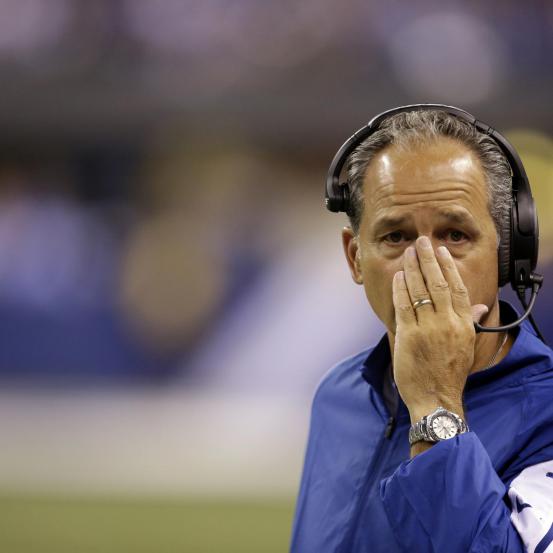- Commissioner’s statement on Ventura, Marte
- Ronnie O’Sullivan: Masters champion ‘felt so vulnerable’ in final
- Arron Fletcher Wins 2017 WSOP International Circuit Marrakech Main Event ($140,224)
- Smith challenges Warner to go big in India
- Moncada No. 1 on MLB Pipeline’s Top 10 2B Prospects list
- Braves land 2 on MLB Pipeline’s Top 10 2B Prospects list
- Kingery makes MLB Pipeline’s Top 10 2B Prospects list
- New Zealand wrap up 2-0 after Bangladesh implosion
- Mathews, Pradeep, Gunathilaka to return to Sri Lanka
- Elliott hopes for rain for Poli
Which of the NFL’s ‘Dumbest’ Strategies Are Smarter Than You Think?
- Updated: May 19, 2016

NFL coaches are stupid.
OK, no, that’s not even remotely true, no matter what midday sports-talk radio and TV want to tell you.
But NFL coaches are old-fashioned, ultra-conservative and a little stubborn. They make many of their decisions as if one false move will get them ridiculed for weeks, then fired.
Can you blame them? Each NFL Sunday, we see tactics and play calls that make the fans on the upper concourse howl and cause the message boards to hyperventilate. Coaches call plays that “everybody” knows have little chance of success.
But does “everybody” really know which plays work more often than others?
With the help of the Football Outsiders in-house database of tens of thousands of sortable NFL plays, I worked out the success rates for several of the most criticized and reviled NFL tactics.
Some strategies probably should be sent to the tactical retirement home with the flying wedge and the dropkick. Others are much more effective than you might think.
So before you criticize the head coach for blowing that big decision, make sure you know the numbers.
Prevent Defense
“Prevent defense” is a broad, vague, overused term and an almost undefinable concept.
Some fans blame the “prevent defense” anytime the home team surrenders a fourth-quarter lead, even if eight defenders blitzed with battle axes on half the plays of the game-winning drive.
Coaches tend to use phrases like “two-minute defense” or “four-minute defense” to describe late-game, hold-the-lead strategies. If a coach says “prevent,” he’s probably talking about an anti-Hail Mary strategy or one of those plays where six defenders line up 19 yards downfield on 3rd-and-20.
So it’s hard to statistically analyze how well these “prevent” strategies work. But we can determine how many defenders rushed the passer in protect-the-lead situations and calculate whether a three- or four-man rush is more effective at “preventing” anything than a five- or six-man rush. Not every four-man rush is a conservative tactic, as anyone who has ever watched the Cardinals or Chiefs can attest, but the numbers give us something objective to work with.
The table below tabulates all 2015 fourth-quarter passing plays when the defense was nursing a one-to-16-point lead; in other words, the game was still close enough to worry about an offensive touchdown. The table shows the first-down rate (touchdowns included), sack rate, interception rate and big-play (20-plus yards) rate allowed. The last thing a defense wants to do when playing with a lead is give up 20-yard chunks of real estate.
The optimal late-game strategy appears to be to rush four defenders. Predictably, blitzing increases the sack and interception rates but also results in more first downs, big plays and yards per play; late-game blitzes when leading are only common when the offense is in scoring position for that very reason. Rushing only three defenders appears to be so conservative that it’s counterproductive, though three-man rushes are much more common late in two-touchdown games than when the defense is clinging to a three-point lead.
Maybe the defensive coordinator really knows what he is doing when he rushes four defenders and drops everyone else into zone coverage in the fourth quarter, perhaps sneaking in a well-timed blitz now and then. Teams blow leads in the fourth quarter because passing offenses are better, faster and more efficient than they were even 10 years ago and rules are designed to favor the offense.
So don’t blame the “prevent defense.” It’s just NFL football.
3rd-and-Long Surrender Plays
The first-down conversion rate for third down and 10 or more yards to go last year was 20.5 percent. That’s tough, but hardly hopeless, which makes you wonder why so many offenses seem so eager to run draw plays and short passes that have little chance of success on 3rd-and-long.
The 3rd-and-long handoff is an easy way to get the home crowd booing. There were 160 handoffs on 3rd-and-long (10 or more yards to go) last season, and only 12 of them (7.5 percent) resulted in first downs or touchdowns.
There are extenuating circumstances to the third-down handoff, though. Of those plays, 35 percent occurred with the offense inside its own 20. Those plays netted a respectable 6.7 yards per rush. When it’s 3rd-and-24 from your own 6-yard line, seven extra yards for your punter may be the best you can hope for. Third-and-long handoffs are also much more common late in lopsided games, when the winning team is just …
continue reading in source www.bleacherreport.com
